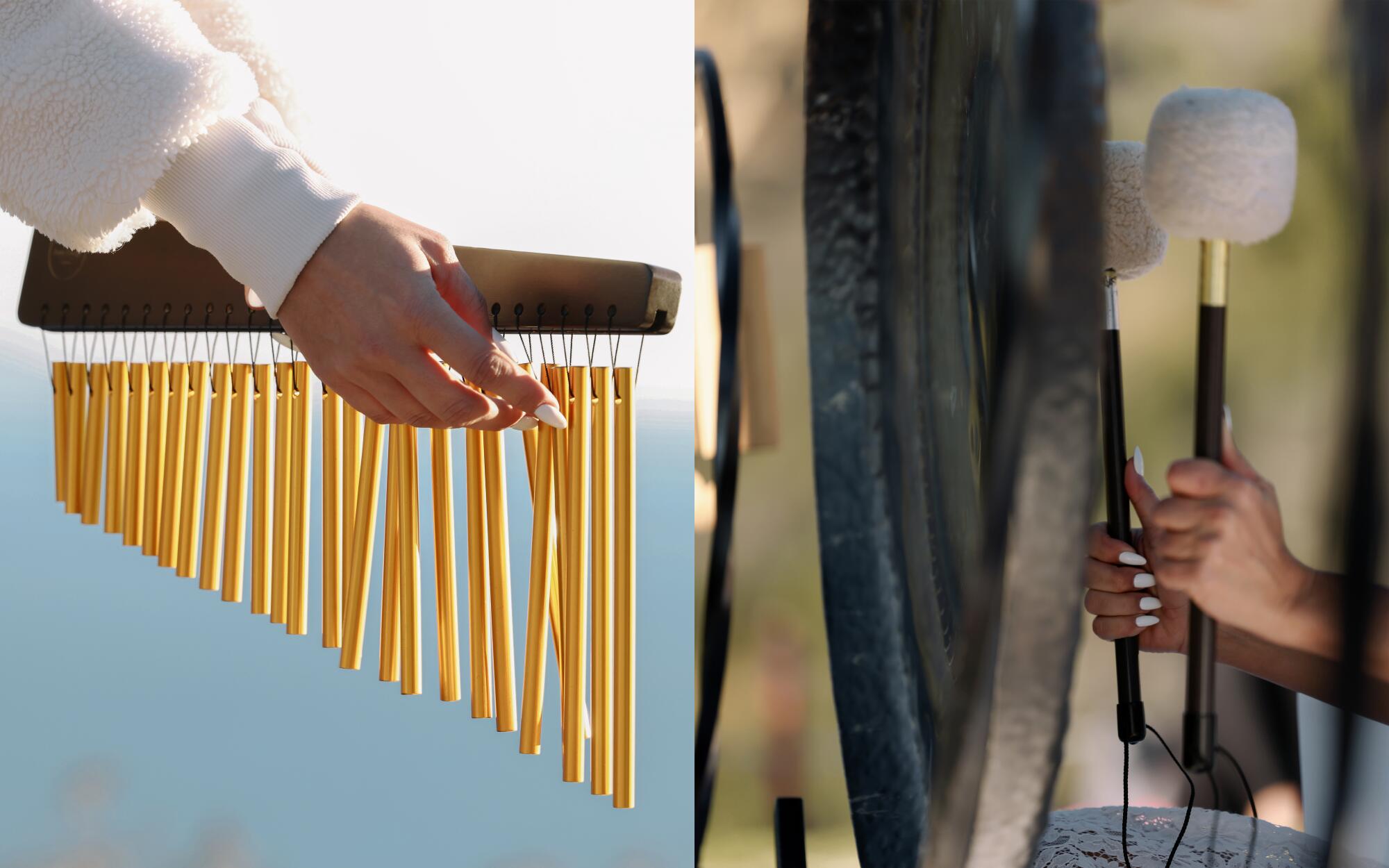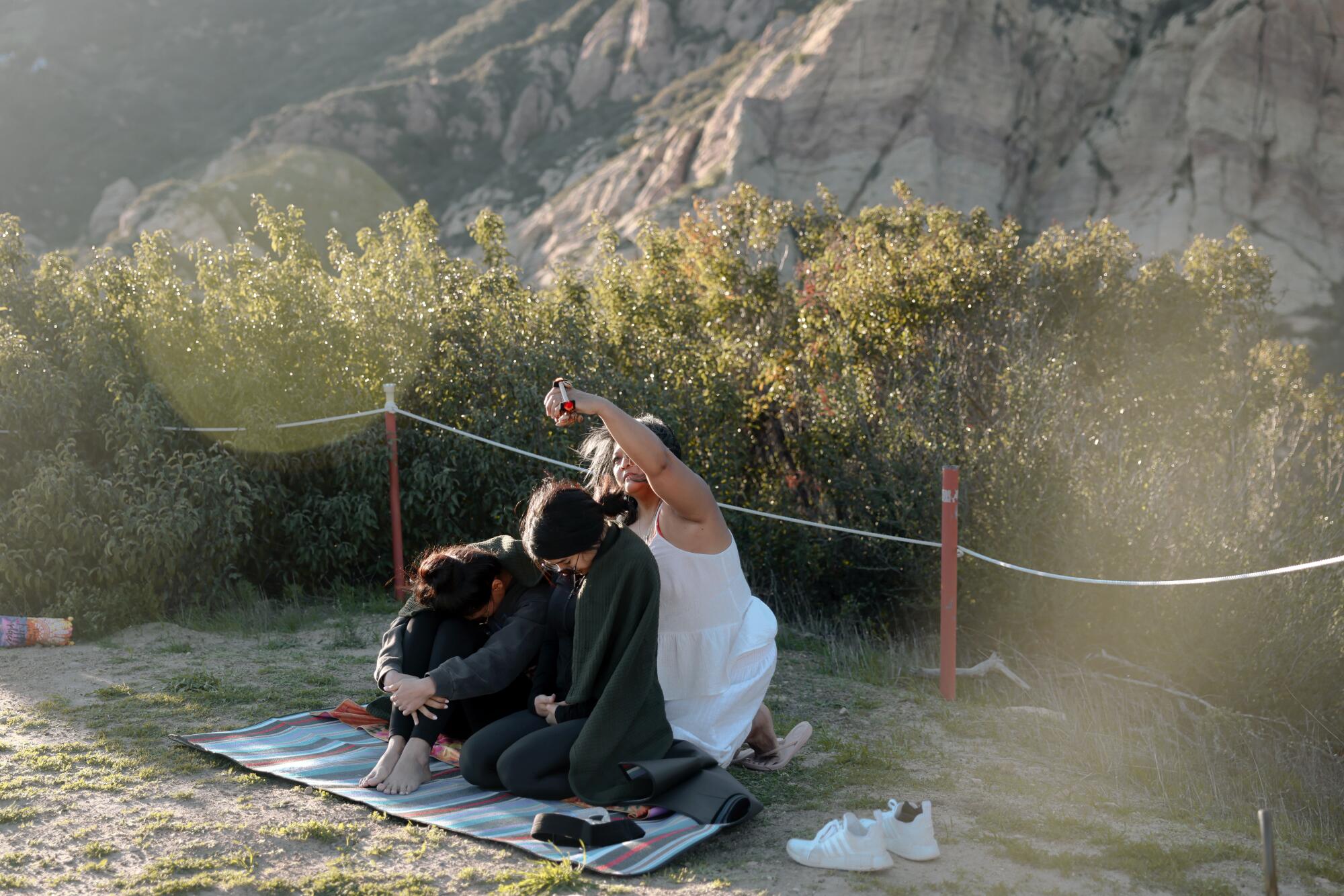
- Share via
In 2015 the Grammy-nominated music producer, songwriter and rapper Maejor, 33, was living every artist’s dream.
The musician, born Brandon Green in Detroit, had started making beats as a teenager. By his mid-20s, he’d appeared on or produced tracks by Drake, Iggy Azalea and Justin Bieber and broke the top 20 in 2013 as Maejor Ali with his single “Lolly.”
The following year, he started experiencing what he calls “excruciating pain” in his arms and legs at night. As it got worse, a doctor gave him a blood test and sent him to an oncologist, who told Maejor that he had leukemia.
Battling fear, grief and depression while undergoing chemotherapy, he self-medicated with drugs, sought professional therapists and went on an ayahuasca retreat at the foot of Mt. Shasta. None proved effective in fighting his feeling of hopelessness.
Then Maejor “started getting introduced to different spiritual communities,” he says via video call. “I started hearing about how people used sound.”
After profound experiences during yoga and meditation sessions, he began researching the mechanics of music and the underlying theories connecting the frequencies of specific notes and wellness. He was intrigued. Burrowing down an internet rabbit hole, Maejor was struck by a debate that had seeped onto YouTube.
Referring to the musical note of A, Maejor explains that for the past 80-odd years, “the standard tuning of music has been A equals 440 hertz.” Such a crucial determination, he says, “is just not questioned, not even really deviated from.”
His belief? Tuning A to a slightly lower 432 hertz, and adjusting scales to calculate this change, sounds and feels better than the “brighter” 440 hertz. Maejor compares this epiphany on his new podcast, “Maejor Frequency,” to “when you let out a huge sigh and your body floods with serotonin and you realize you’ve arrived at the place that you belonged all along.”
He adds, “Any opportunity I get to plug sound healing or intentional frequency use into this world, I will — and it’s seeping over into every aspect of my life.”
When used for calculating frequencies, “hertz” is a measurement of repeating patterns that signifies the cycles per second at which air molecules vibrate as sound travels. A store-bought tuning fork forged to resonate in the key of A, when struck, will cause a wave of 440 hertz to vibrate air particles as it soars toward your eardrums.

For the Los Angeles-based Maejor and millions of others meditating to or creating so-called “frequency music” on YouTube, Spotify and TikTok, the frequency of 432 hertz, though, is more aligned with nature’s patterns. As such, they say, when that root frequency activates the eardrums, it fills you with positive vibrations.
Prolonged listening to these 432-hertz tones, claim various believers, reduces stress, “detoxifies” cells and organs, eliminates fear and wipes out negativity. Some advocates of a different pitch-based system argue that its particular root tone “repairs DNA and brings positive transformation.” Other frequencies are said to bring love and compassion and allow the attuned to connect to a higher self.
These emergent beliefs are part of a long fascination with “pitch-correcting” the Western music scale. Over the past decade, the conversation has eased its way from academic and esoteric circles and onto social media and wellness platforms.
“Things that I used to talk about a few years ago that seemed very far out or woo-woo are now more normal,” Maejor says.
He documents his journey through his cancer diagnosis — it’s in remission — and turn toward 432-hertz music on his Audible podcast, produced by L.A.-based company Audio Up. Soundtracked by gongs, singing bowls, om-chanting gurus and his own music, “Maejor Frequency” centers around the artist — who also produces electronic dance music with Martin Garrix as Area21 — traveling the world in search of information. He devotes a big chunk of his research to the Los Angeles community of sound therapists and thinkers.
That stands to reason: Southern California is the major driver of a U.S. wellness industry that generates $1.5 trillion annually.
Music and harmonious tones have long scored all sorts of wellness activities, whether massage therapy, yoga classes or meditation sessions. In the past couple of years, people made anxious or unwell by COVID-19 have increasingly turned to less traditional means of spiritual and physical healing.
In Los Angeles, a search on Yelp reveals dozens of practitioners claiming to “retune” the spirit to its natural frequency with sound baths. Apps such as Calm, Meditopia and Headspace offer daily regimens designed to encourage mindfulness.
On YouTube, hubs such as Meditative Mind, ZenLifeRelax and Gaia regularly release content, much of it whooshy synthesizer music, that has generated billions of views. Spotify and other music platforms offer a lifetime’s worth of pure tones for meditating. TikTok’s “frequency music” hashtag offers countless portals into a range of aural philosophies.
The beliefs nestled within various camps have absorbed inspiration from chants sung during ancient Gregorian masses; the seven chakra meditation points used in Hindu-based mindfulness practices; the Buddhist beliefs on drone-driven serenity; the West Coast new-age music community; and ideas born from sound therapy practitioners working to alleviate trauma.
“432 is one with the world around it. We are all one. Everything is one,” Maejor testifies on his podcast.
The argument for a switch from 440 to 432 hertz rests as much on feeling as it does on science.
Most people wouldn’t be able to discern such microtonal shifts up or down 8 hertz.
Ruth E. Rosenberg, a music professor at University of Illinois-Chicago, started studying 432-hertz music in the mid-2010s when a student mentioned a fondness for it.
After researching the alleged negativity of 440 hertz, Rosenberg was struck by “this idea that pop music could be harmful to you.”
Since Rosenberg first came across the ideas, artists including Prince, Aphex Twin and Kanye West have chimed in on the positive and negative effects of specific frequencies. “If I play with frequencies, I can target certain parts of the mind,” claimed the late rapper XXXTentacion.
YouTube channels that pitch-shift today’s biggest pop songs from 440 to 432 hertz claim their versions to be more “in tune” with the universe’s frequency. Shortly after Taylor Swift released her 10-minute version of “All Too Well,” an unauthorized 432-hertz version arrived.
“If you do an A and B comparison between a 432 and a 440, most people don’t hear an audible difference. But people will tell you they profoundly do, and what I took from the listeners is that they experience something really different,” says Rosenberg.
One voice Maejor was drawn to as he was battling depression and searching for answers was Ana Netanel, who describes herself on her Shakti Sound Bath website as an “international wellness practitioner and instructor specializing in the restorative and healing power of sound frequency and vibration.”


Netanel, who appears in an episode of “Maejor Frequency,” has preached the power of kundalini yoga and sound baths for about two decades. She and her baths, which include singing bowls tuned to 432 hertz, have appeared on TV shows “Grey’s Anatomy” and “The Hills.” In December during an episode of the Facebook Watch show “Cardi Tries,” Netanel gave rapper Cardi B a drone-filled sound bath with bowls set to 432 hertz.
Says Netanel during a recent call, “Healing sounds help to activate the parasympathetic nervous system, which is responsible for rest and digest, and they really help to relax.” Like Maejor, Netanel’s goal “is to bring sound healing to the mainstream.”
If they succeed, they will likely face pushback from the medical and science communities.
“So far as I can tell there is very little solid scientific evidence supporting any of these interesting new ideas,” says Dr. Robert Bilder, director of the Tennenbaum Center for the Biology of Creativity at the UCLA Semel Institute for Neuroscience and Human Behavior. One of his current students, he says, is getting ready to begin “a randomized controlled trial to see if Tibetan singing bowls have more benefits for psychological well-being relative to a simple relaxation meditation session. But so far there are few rigorous studies of these effects.”
“That’s what I’ve been calling for for the last quarter-century, and I applaud the doctor for financing and supporting research in the field,” says Leonard G. Horowitz, an author, retired dentist and longtime advocate of meditating to specific frequencies.
Horowitz and his followers have concluded that yet another frequency holds healing powers. He lays out his conviction in his “The Book of 528: Prosperity Key of Love.” Published in 2011, it argues that neither the 440- nor the 432-hertz tone possesses secret energy.
That magic number is 528 hertz, known to musicians as a “high C,” to podcasters as “the frequency of love” and to a new breed of YouTube numerologists as a key number in the so-called “solfeggio frequency” system of audio healing.
Horowitz, 69, first wrote about the “solfeggio system” numbers in a wild 1999 book called “Healing Codes for the Biological Apocalypse.” (The term “solfeggio” is a variation on the Italian term solfège, which has long been used to teach novice music students pitch, sight-reading and note discernment. Do, re, mi, fa, sol, la, ti is a solfège.)
The aim of “Healing Codes” hardly sounds harmonious: Horowitz, a decades-long anti-vaccine activist, wrote in the introduction that it was “intended to slay the earth’s deadliest dragon — a beast that breathes God’s power and expires pestilence and pain on His people.”
“The way that the entire universe is constructed,” Horowitz later proclaimed, “is through a musical, mathematical matrix composed of nine core creative frequencies.” As measured in hertz, those numbers are 174, 285, 369, 417, 528, 639, 741, 852 and 963. Meditating or actively listening to these tones, according to Horowitz, generates specific positive outcomes.
Try 741 hertz, writes Horowitz, “if you regularly feel uncertain or unclear about your life and relationships or having trouble perceiving the truth in situations.” Tune into 852 hertz when you’re experiencing “depression and mental fog, chronic fatigue, materialism and greed, and headaches.”
Like those of QAnon, Horowitz’s writings and the numerology they convey have spread well beyond their source. Videos connected to his solfeggio system numbers — most crucially, 528 hertz — have clocked more than 1 billion views on YouTube. (Horowitz’s online store sells a 528-hertz tuning fork that will set you back $120.)
Horowitz’s theories have resonated with Josh Laven, 25, a Newport Beach-based musician, producer and TikTok creator who makes music as Anomal. A self-described “quantum sound healer,” the musician has incorporated Horowitz’s voice into one of his songs, resulting in the two becoming friendly. “It was such a beautiful conversation, and his energy and his vibration really felt like it matched.”
Laven has held YouTube symposiums, produced 528 music and eagerly advocated for the solfeggio system.
“It’s such a powerful time,” he says by phone.
In a 2020 TikTok video that’s been viewed more than 2 million times, Laven issued a kind of call to arms. “If you listen to frequency music, stop listening to 432 hertz! It is not what they say it is. It is not backed by science. It is not a miracle tone.”
Laven, who is unvaccinated due in part to the influence of Horowitz’s theories, was drawn to Horowitz during what he calls “a dark time” in his life: the end of a long-term relationship and a decision to quit hockey, which he’d played since elementary school and had earned him a college scholarship.
Then, he says, “I found this music that was tuned differently … and stimulated so many new energy centers. I was able to perform better mentally, physically, emotionally, everything.”
Podcaster and musician Matt Marble, whose series “Secret Sound” explores the history of American musical spiritualist composers and movements, dismisses Horowitz’s claims on frequencies, calling them part of a “basic strategy to create fear and then provide a solution to the fear.” He describes the author’s hypotheses as “a total mishmash of metaphysics” and notes that Horowitz seems to have adjusted his system over time “to make it more and more accessible.”
“The frequencies relating to these solfeggio tones are complete bulls—,” Marble concludes.
“From the perspective of the science of sound, there’s nothing special about these particular frequencies,” says Robin James, an associate professor of philosophy at University of North Carolina-Charlotte who focuses on music. Describing the frequency conversation as being part of “the wellness-influencer-Goop-pseudoscientific space,” she calls the solfeggio system “bonkers numerology.”
“It makes sense within that system, but not within the physics of sound,” she says.


Ana Netanel and her tribe of white-dressed sound-healing students regularly converge on private Malibu land overlooking the Pacific to relax to the sound of singing bowls tuned to 432 hertz and gongs that blitz the eardrums with volumes of various frequencies.
On a recent Sunday afternoon, about 50 of us are seated in the kind of spot you picture when someone says, “outdoor sound bath in the hills of Malibu.” Situated inside a wide circle of gongs, bowls, shakers and rain sticks, we set up yoga mats, blankets and pillows to lie down and be bathed.
Netanel invites us to set our intentions via a kundalini chant. We abide. In the distance, the very untuned rumble of weekend motorcyclists pierces the bliss. An ocean breeze wobbles the gongs behind her.
Some have brought eye pillows to shield the bright midafternoon sun. We recline into savasana, or corpse pose, and I cover my face with a knit cap that shades the sunlight. Sitting before a trio of gongs, Netanel starts gently tapping a padded mallet on the largest of them; her students do the same on theirs. A deep, harmonic drone cascades across the landing and vibrates my eardrums.
The next 75 minutes feel like a rush of color. My eyes closed, the ringing gongs seem to occupy the oxygen as they storm the mess of random frequency data in my head.
Gradually the gong tones start expanding with higher frequencies as the practitioners activate tuned bowls. A harpist gently strums out vague dots of melody.
Overhead, an airliner en route to LAX adds a wash of distant white noise to the sound-makers wandering among the relaxed with rain sticks, shakers and bells. At some point, the players return to gongs, activating them with a power that at first feels like angels revving their wings, then God piloting a jet-fueled chariot. During Cardi B’s sound bath, she described this part as “scary.”
I’d describe it otherwise: gorgeous, loud, all-consuming harmonies and tones that at various points seem to make time vanish. At one point, I remove my eye covering. With my eyes still closed and lost in mindful bliss, the blackness turns an otherworldly pink hue, which might suggest that I’m attuned to the universe on some metaphysical level — or that the day’s fading sunlight is now penetrating my eyelids.
Fifteen minutes later, I’m on the winding Rambla Pacifico Street, a resonant hum scoring my drive home. It’s reverberating from a sound-focused experience that had less to do with any specific frequencies — for all I know, those bowls were tuned to 666 hertz — and everything to do with getting lost through meditative, focused listening.
Truth be told, 440 hertz has never let me down — as far as I know.
More to Read
The biggest entertainment stories
Get our big stories about Hollywood, film, television, music, arts, culture and more right in your inbox as soon as they publish.
You may occasionally receive promotional content from the Los Angeles Times.










